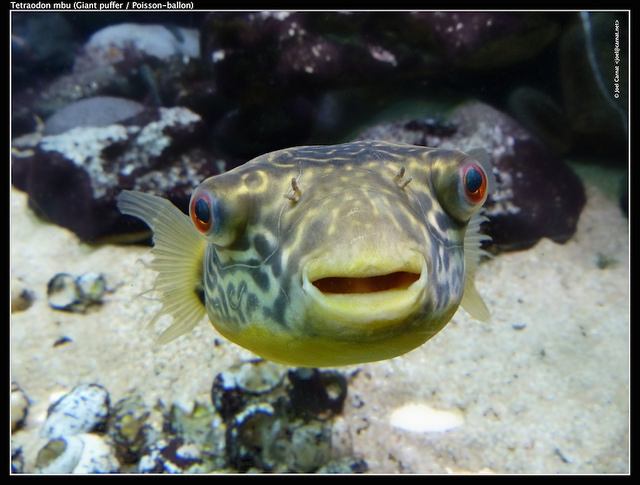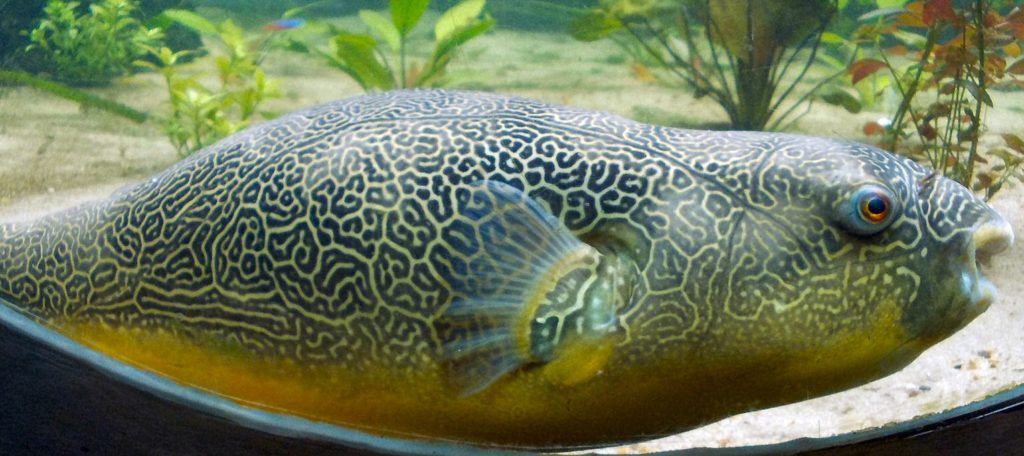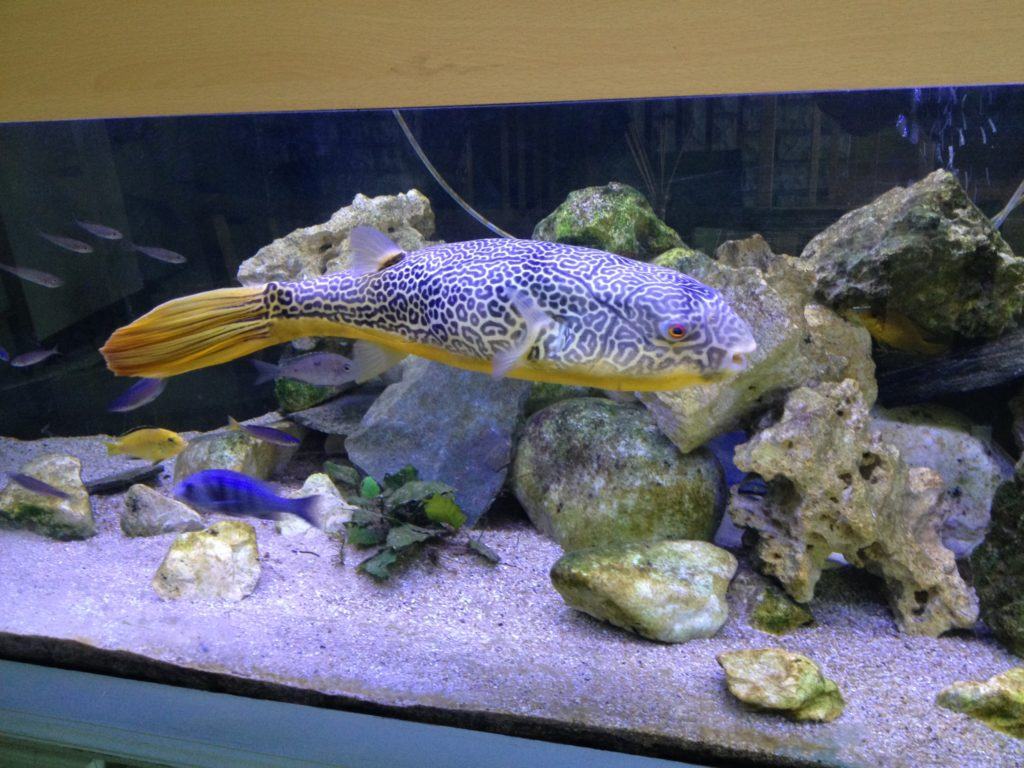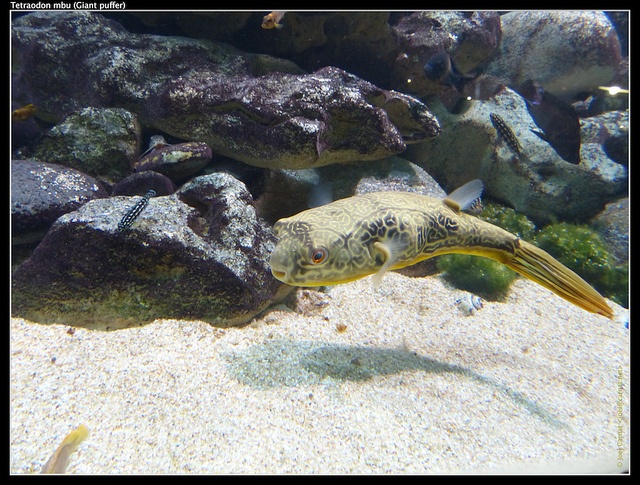A favorite among experienced aquarists, puffer fish are wonderful to raise. It’s not hard to understand why; many consider the puffer to be one of the most interesting species to keep.
They are often regarded as having the most distinct personalities – not only when compared to other species, but even among themselves. Two puffers within the same tank will have very different behaviors and interact with you in their own unique way.
They are also regarded as a fairly intelligent species and have been reported as smart enough to recognize shapes. Puffers have been known to recognize their owners and may even beg for food during feeding time.
Aside from that, puffer fish are a wonder to survey. Their large, expressive eyes, paired with a face that always seems to be smiling, makes them an endearing pet. They’re also exciting to view when they inflate, especially for more colorful sub-species.
While they are a charming fish, they can be a challenge to raise. For those who enjoy a challenge, however, the puffer is an ideal pick.
Before you dive in, let’s explore one in particular – the Mbu puffer.
Contents
The Mbu Puffer
Many aquarists choose the brightest, most colorful species. Some opt for those that get along well with others, to build a community tank filled with activity and diversity.
There are those that would rather species that are hardy, tough, and easy to care for. Others still, however, go for size.
If you’re one of the latter, you may already have an eye out for the biggest freshwater puffer fish there is: the Mbu puffer.
Growing to at least 20 inches in size as an adult, the Mbu puffer fish is known in aquarist circles to be a daunting pet. And, of course, they can grow between two to three times their normal size when threatened – as they will inflate to defend themselves.
With the scientific name Tetraodon Mbu, they’re also called the Giant Puffer, Giant Green Pufferfish, and Congo River Puffer.
They are known to be generally aggressive and do not live well in community tanks – especially with fish not of their own species.
They are often found solitary in their own tanks, maintained by aquarists who already have a lot of experience raising fish.

Origins
The Mbu puffer originated in African waters, specifically in the Congo River Basin, the shores of Lake Tanganyika, and rivers in Tanzania.
They naturally live in freshwater, specifically brackish water.
Lifespan
The Mbu puffer grows quickly, with their lifespans ranging from eight to twelve years. They commonly live around ten years in total.
At this age, the Mbu can grow up to 20 inches in length. Fish shops often sell them as juveniles.
When shopping for a Mbu, keep an eye out for the amount of space that they are allocated. A small tank may mean that this Mbu isn’t receiving adequate care, which means that they may be more susceptible to diseases and growth defects.
Mbu Puffer Care
Caring for puffer fish is a challenge – even more so when dealing with the Mbu. Because of their size, the problems that most aquarists come across when raising puffers become even more difficult.
Nonetheless, as long as you keep up with their diet and tank requirements, you have a good chance of successfully raising a Mbu to adulthood.
Aquarium Conditions
Creating the perfect Mbu puffer fish habitat is key to ensuring that these giants stay at their best.
Here are a few things to consider when setting up an aquarium for this species.
Tank Size
When it comes to the largest freshwater species of puffer fish, tank size becomes even more crucial than it already is for other fish types.
In fact, tank size can be the number one factor why Mbu puffers don’t get the ideal care that they need.
Sources for the recommended tank size vary wildly, with Aquarium Wiki recommending 219 gallons and Tropical Fish Site recommending at least 528 gallons. Nonetheless, the consensus is: the bigger the tank, the better. A too-small tank will have them developing illnesses, failing to grow to their full size, and absolutely fighting with other species, should you decide to keep them with others.

Keeping that in mind, Aquarium Co-Op points out a different way of looking at the recommended tank size for the Mbu puffer.
Rather than the total volume of the tank, they recommend that footprint be the number one factor when shopping for a tank.
In other words, look for a longer tank, not a taller one. This gives the Mbu a larger area to swim around in, which results in more exercise and a happier mood.
Also note that unless you want to mix and match possible tank mates (inevitably ending with a few casualties), your Mbu puffer will probably be alone in this tank.
Plants and Substrate
Pufferfish commonly do best with a sandy substrate, smooth rocks, and driftwood.
Should you desire, plants could also be added to the aquarium, as long as you don’t mind occasional nips at the leaves. If you do add plants, just remember to give enough space for your Mbu to swim in.
This video goes into some more details on the Mbu Puffer fish.
Mbu Puffer Water Requirements
The Mbu naturally lives in freshwater. For that reason, they don’t need to have salt added to their tank.
This makes them far easier to care for than their saltwater cousins, which are even more susceptible to health issues.
pH and Temperature
Because of their natural habitat, the Mbu does best in alkaline water, slightly above neutral. They do well in 7 to 8 pH.
Temperatures should be from 75 to 80 degrees Fahrenheit, or 24 to 26 degrees Celsius.
Current
Being of a large size, water current may not be a huge factor for the Mbu. While that may be the case, a strong water current is still necessary to ensure that your tank remains clear of detritus.
Filtration
Aside from the amount of space and water that caring for a Mbu puffer entails, its size can also give you problems when it comes to filtration.
The Mbu is a massive fish, and with that, it produces a massive amount of waste. This is compounded by the fact that puffer fish, as a species, are sensitive to poor water quality.
This is due to their anatomy; puffer fish have no scales or gill covers, which means that they get the full effect of a badly cycled tank. Puffer fish also tend to be messy eaters, leaving food lying around on the substrate.
For these reasons, your aquarium’s filtration system should be top-notch. Keeping this type of puffer will require you to be able to filter massive amounts of waste, as well as keep up with weekly water changes.
Petcha recommends a 50% water change once a week. If possible, look into automated water changing systems.

Feeding Mbu Puffers
Aside from their size, their diet can also be a problem for aquarists. Consisting of a mostly shelled food diet, the Mbu should be fed clams, mussels, and snails.
While this diet can be a challenge to keep up with, it provides two benefits on your end: One, it trims down the Mbu’s beak, making sure that it stays sharp. Two, shells can also be left on the substrate, helping buffer the water.
It is recommended to feed your Mbu shelled fish five days a week, and softer foods for the other two days.
For those who consider adopting a Mbu, note that this diet can cost a lot more compared to other food options. Aquarium Co-op compares the costs to feeding a large dog, clocking at $300 a month.
The Aquarium Wiki also notes that Mbu puffers may ignore food that’s of inadequate size. A good rule of thumb is that food should be the size of a penny or smaller.
The Mbu also tends to have eyes far apart on their head and may need to line themselves up with food before taking a bite.
Breeding
Because of their size, tank breeding can be out of the question for the Mbu puffer. According to Petcha.com, there have been no accounts of successfully breeding Mbu puffer fish in captivity.
The inability to reliably sex Mbu puffers also complicates efforts. Needless to say, attempts to breed this species can be incredibly arduous, and not worth the resources.
Seriously Fish even goes as far as to say that any serious attempt should be undertaken with the aid of an Olympic-sized pool, which, considering their size, may not be completely far-fetched.
Here’s an example of a Mbu Puffer at feeding time.
Mbu Puffer Tank Mates
Mbu puffer tank mates can be hard to find,and ultimately depends on the personality of the fish. However, compared to other species, puffers tend to have distinct personalities, and that is even truer with the Mbu.
For this reason, it is plausible for you to have a particularly calm and friendly Mbu, which would be more than happy to leave its tank mates alone.
You could also try to mix and match the Mbu with some fish species to see if they will get along. Needless to say, the chances for casualties are high.
If you’d rather remain on the safe side, it’s better to give a single Mbu a tank all of its own. Because of their size, it’s fairly easy for them to chomp on smaller fish, no matter how peaceful they may be. Their beak-like mouth also doesn’t bode well for others.
Ultimately, however, tank mates will still depend on the personality of your Mbu puffer. While they are generally aggressive and intolerant, you may find yourself lucky.
Here are a few things you can do to ensure the harmony of your community tank:
Give Your Fish Enough Space
Ensuring that your Mbu has enough room to swim on its own will lessen the chance of it coming across other species.
In doing so, you lessen the opportunity for conflict – which can undoubtedly result in a death.
As with any community aquarium, consider the necessary space requirements that each species needs, so they’re not motivated to fight for dominance.
Feed Your Mbu Well
Keeping your Mbu well-fed will lower the chances of it suddenly snapping and eating tank mates.
Of course, there may be other reasons for your Mbu to seek out alternate fish species, but a well-fed Mbu has one less reason on its list.

Pair With Agile Fish
Puffers are not the best tank mates, and aquarists have tried solving this by pairing them with faster fish species.
Guppies, tetras, and plecos have been known to live happily with more peaceful Mbu puffers, because they stay out of range.
Work with the Mbu
Of course, if you can’t beat them, join them. There are aquarists who work with the Mbu’s tendency to eat tank mates, using it as a way to curb populations of certain fish species.
If you have a species that tends to breed fast, a Mbu in the same tank can be a good compromise.
If You’re Up for a Challenge
Needless to say, the Mbu is a daunting fish to raise. There are many things to watch out for, even without factoring in their size.
As puffer fish, they’re an aggressive species, with sharp teeth capable of ripping smaller fish to shreds. They’re also sensitive to bad water conditions and sudden changes in their environment.
The Mbu compounds these problems because of their gigantic size, making things even harder for new or experienced fish-keepers. After all, an issue in a ten-gallon tank is far easier to handle than one in a tank containing 500 gallons or more.
Despite all that, a deep fondness is still held for this giant fish, and they’re often referred to as something more endearing: an underwater puppy.
With their expressive eyes, striking personalities, and an incredible appetite, the Mbu is indeed like an endearing, underwater dog. It is for these reasons that people still brave raising a Mbu puffer, despite the challenges that they have to overcome.
So, if you’re in the mood for a challenge, why not give the Mbu a chance? This giant, underwater puppy may just be the perfect fit for you.
Do you own a Mbu Puffer?


